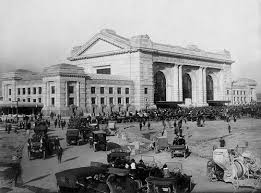 |
| Union Station - Kansas City, Missouri 1933 The Beaux-Arts station opened on October 30, 1914. Encompassing 850,000 square feet, it was the second-largest train station in the country. The design by Jarvis Hunt had a main hall for ticketing, and a perpendicular hall extending out over the tracks for passenger waiting. The Grand Hall ceiling was 95 feet high and the Grand Hall clock had a six-foot diameter face. Due to its central location, Kansas City remained a hub for both passenger and freight rail traffic. Union Station made headlines on June 17, 1933, as four unarmed FBI agents were gunned down by gang members attempting to free captured fugitive Frank Nash. Nash was also killed in the gun battle. The “Kansas City Massacre” highlighted the lawlessness of Kansas City under the Pendergast Machine and resulted in the arming of all FBI agents. In 1945, annual passenger traffic peaked at 678,363. As train travel declined beginning in the 1950s, the city had less and less need for a large train station. By 1973, only 32,842 passengers passed through the facility, all passenger train service was now run by Amtrak, which eventually suspended service, and the building was beginning to deteriorate. The building continued to decay until, in 1996, residents in five counties throughout the metro area in both Kansas and Missouri approved the so-called "bi-state tax", a 1/8 of a cent sales tax, part of which helped to fund just under half of the $250 million restoration of Union Station. Renovation began in 1997 and was completed in 1999. The remaining money was raised through private donations and federal funding. Today Union Station receives no public funding. Current operating costs are funded by general admission and theater ticketing, grants, corporate and private donations, commercial space leases and facility rental. In 2002, Amtrak restored passenger train service to the station. There are currently two trains daily to and from St. Louis, one train daily to Chicago, and one train daily to the southwest (ultimately to Los Angeles). |
No comments:
Post a Comment